Abstract
The viability of Plasmodium falciparum in culture was assessed by [3H]hypoxanthine incorporation during 24 h of incubation with lactoperoxidase, glucose-glucose oxidase, hydrogen peroxide, halides, or thiocyanate, alone or in combination. Synergistic inhibition was produced by the following combinations: lactoperoxidase plus hydrogen peroxide, lactoperoxidase plus glucose-glucose oxidase, and lactoperoxidase plus hydrogen peroxide plus halides or thiocyanate. These inhibitory effects were reversed by catalase and glutathione. The presence of plasmodial crisis forms inside the erythrocytes suggests that the oxygen-dependent microbicidal system of phagocytes has a killing effect.
Full text
PDF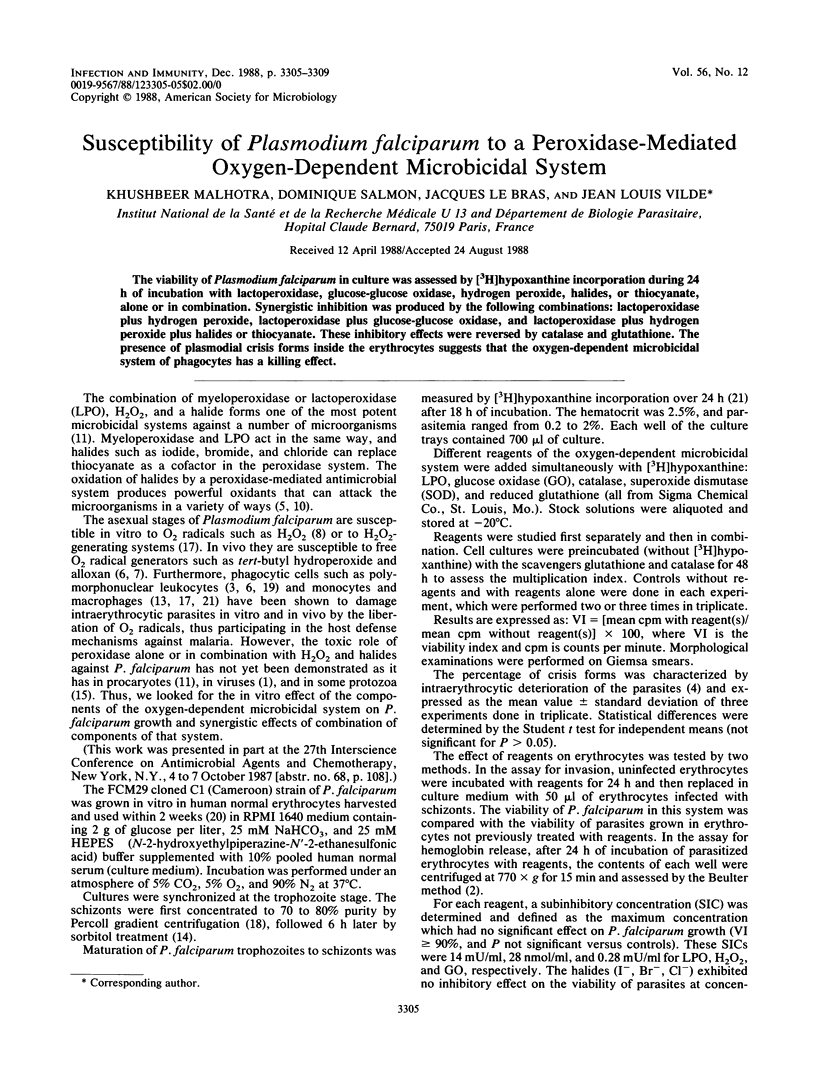
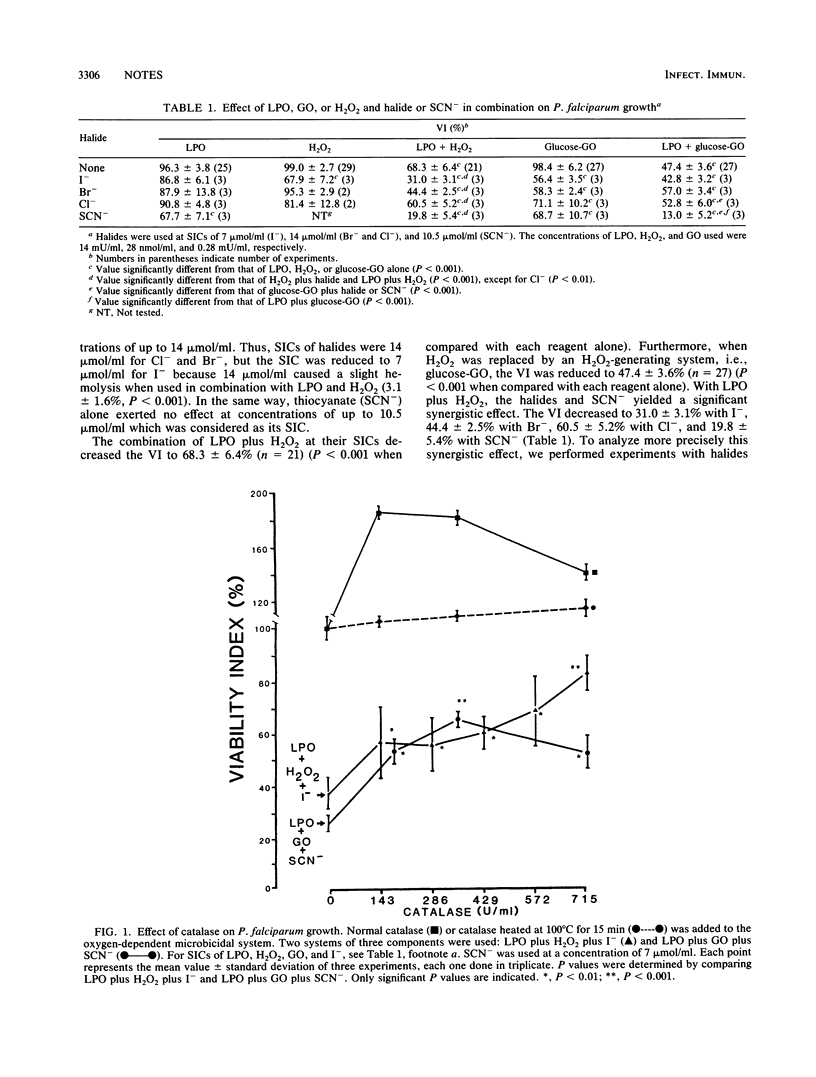
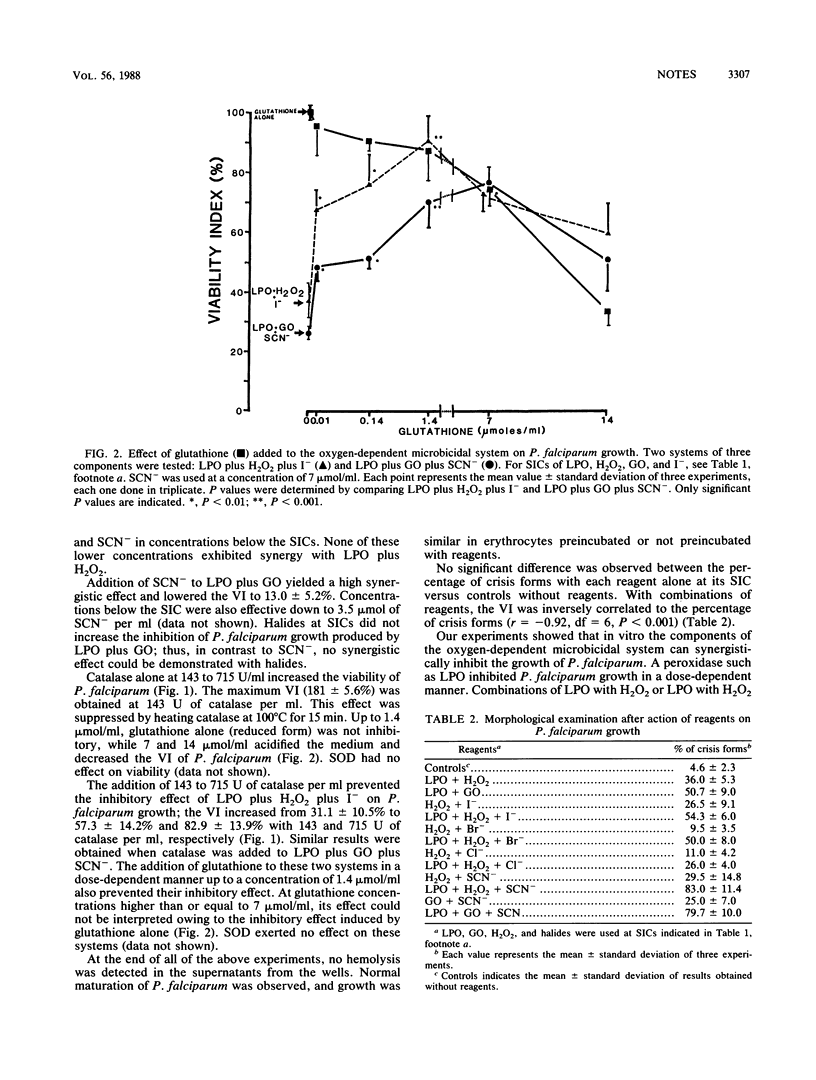
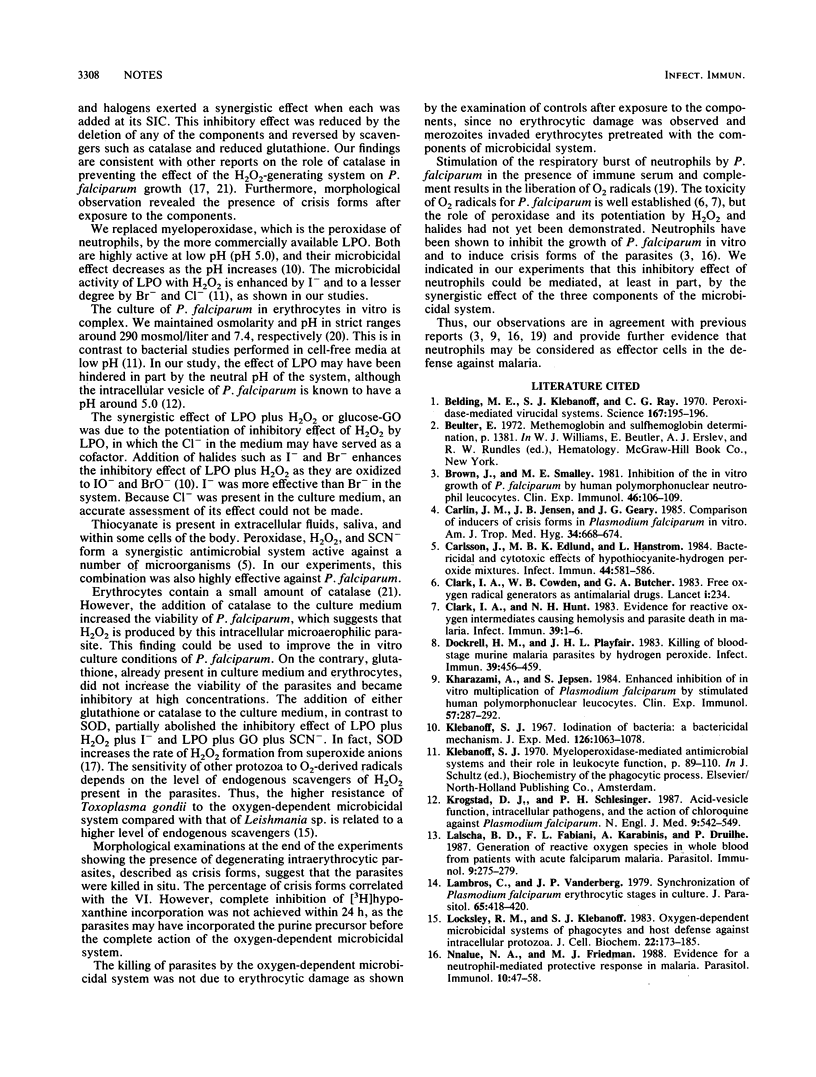
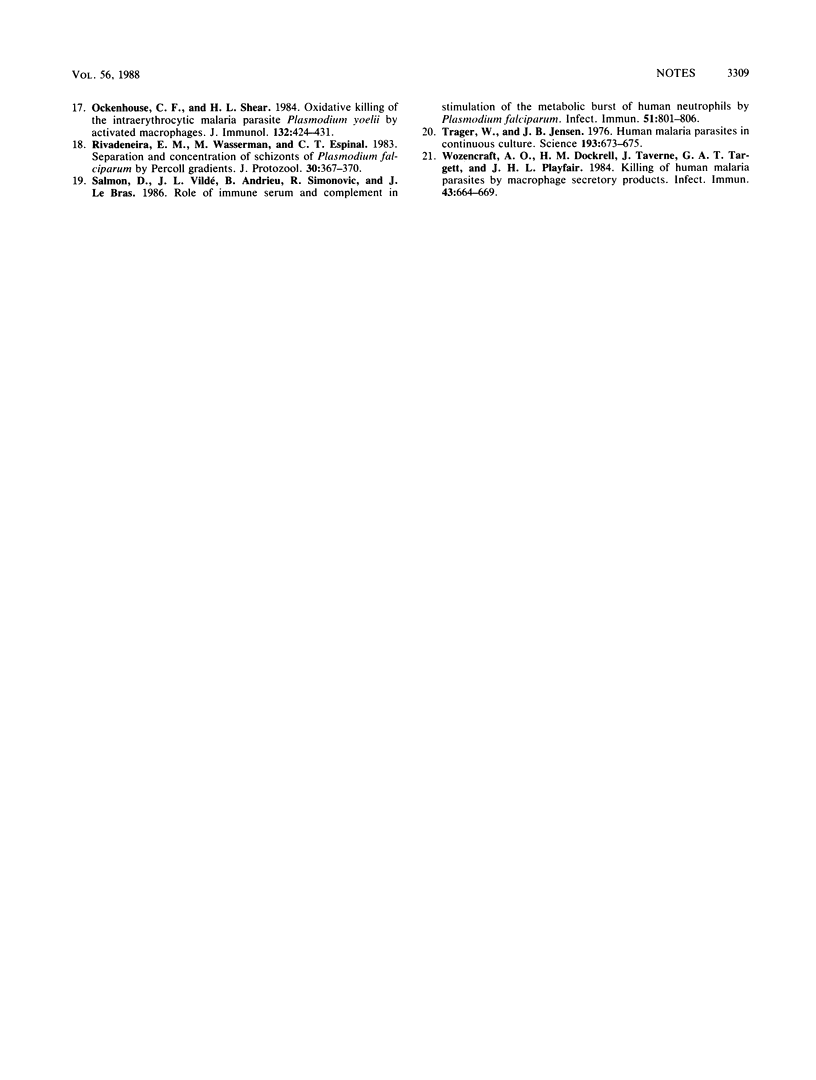
Selected References
These references are in PubMed. This may not be the complete list of references from this article.
- Belding M. E., Klebanoff S. J., Ray C. G. Peroxidase-mediated virucidal systems. Science. 1970 Jan 9;167(3915):195–196. doi: 10.1126/science.167.3915.195. [DOI] [PubMed] [Google Scholar]
- Brown J., Smalley M. E. Inhibition of the in vitro growth of Plasmodium falciparum by human polymorphonuclear neutrophil leucocytes. Clin Exp Immunol. 1981 Oct;46(1):106–109. [PMC free article] [PubMed] [Google Scholar]
- Carlin J. M., Jensen J. B., Geary T. G. Comparison of inducers of crisis forms in Plasmodium falciparum in vitro. Am J Trop Med Hyg. 1985 Jul;34(4):668–674. doi: 10.4269/ajtmh.1985.34.668. [DOI] [PubMed] [Google Scholar]
- Carlsson J., Edlund M. B., Hänström L. Bactericidal and cytotoxic effects of hypothiocyanite-hydrogen peroxide mixtures. Infect Immun. 1984 Jun;44(3):581–586. doi: 10.1128/iai.44.3.581-586.1984. [DOI] [PMC free article] [PubMed] [Google Scholar]
- Clark I. A., Cowden W. B., Butcher G. A. Free oxygen radical generators as antimalarial drugs. Lancet. 1983 Jan 29;1(8318):234–234. doi: 10.1016/s0140-6736(83)92603-x. [DOI] [PubMed] [Google Scholar]
- Clark I. A., Hunt N. H. Evidence for reactive oxygen intermediates causing hemolysis and parasite death in malaria. Infect Immun. 1983 Jan;39(1):1–6. doi: 10.1128/iai.39.1.1-6.1983. [DOI] [PMC free article] [PubMed] [Google Scholar]
- Descamps-Latscha B., Lunel-Fabiani F., Kara-Binis A., Druilhe P. Generation of reactive oxygen species in whole blood from patients with acute falciparum malaria. Parasite Immunol. 1987 Mar;9(2):275–279. doi: 10.1111/j.1365-3024.1987.tb00507.x. [DOI] [PubMed] [Google Scholar]
- Dockrell H. M., Playfair J. H. Killing of blood-stage murine malaria parasites by hydrogen peroxide. Infect Immun. 1983 Jan;39(1):456–459. doi: 10.1128/iai.39.1.456-459.1983. [DOI] [PMC free article] [PubMed] [Google Scholar]
- Kharazmi A., Jepsen S. Enhanced inhibition of in vitro multiplication of Plasmodium falciparum by stimulated human polymorphonuclear leucocytes. Clin Exp Immunol. 1984 Aug;57(2):287–292. [PMC free article] [PubMed] [Google Scholar]
- Klebanoff S. J. Iodination of bacteria: a bactericidal mechanism. J Exp Med. 1967 Dec 1;126(6):1063–1078. doi: 10.1084/jem.126.6.1063. [DOI] [PMC free article] [PubMed] [Google Scholar]
- Krogstad D. J., Schlesinger P. H. Acid-vesicle function, intracellular pathogens, and the action of chloroquine against Plasmodium falciparum. N Engl J Med. 1987 Aug 27;317(9):542–549. doi: 10.1056/NEJM198708273170905. [DOI] [PubMed] [Google Scholar]
- Locksley R. M., Klebanoff S. J. Oxygen-dependent microbicidal systems of phagocytes and host defense against intracellular protozoa. J Cell Biochem. 1983;22(3):173–185. doi: 10.1002/jcb.240220306. [DOI] [PubMed] [Google Scholar]
- Nnalue N. A., Friedman M. J. Evidence for a neutrophil-mediated protective response in malaria. Parasite Immunol. 1988 Jan;10(1):47–58. doi: 10.1111/j.1365-3024.1988.tb00202.x. [DOI] [PubMed] [Google Scholar]
- Ockenhouse C. F., Shear H. L. Oxidative killing of the intraerythrocytic malaria parasite Plasmodium yoelii by activated macrophages. J Immunol. 1984 Jan;132(1):424–431. [PubMed] [Google Scholar]
- Rivadeneira E. M., Wasserman M., Espinal C. T. Separation and concentration of schizonts of Plasmodium falciparum by Percoll gradients. J Protozool. 1983 May;30(2):367–370. doi: 10.1111/j.1550-7408.1983.tb02932.x. [DOI] [PubMed] [Google Scholar]
- Salmon D., Vilde J. L., Andrieu B., Simonovic R., Lebras J. Role of immune serum and complement in stimulation of the metabolic burst of human neutrophils by Plasmodium falciparum. Infect Immun. 1986 Mar;51(3):801–806. doi: 10.1128/iai.51.3.801-806.1986. [DOI] [PMC free article] [PubMed] [Google Scholar]
- Trager W., Jensen J. B. Human malaria parasites in continuous culture. Science. 1976 Aug 20;193(4254):673–675. doi: 10.1126/science.781840. [DOI] [PubMed] [Google Scholar]
- Wozencraft A. O., Dockrell H. M., Taverne J., Targett G. A., Playfair J. H. Killing of human malaria parasites by macrophage secretory products. Infect Immun. 1984 Feb;43(2):664–669. doi: 10.1128/iai.43.2.664-669.1984. [DOI] [PMC free article] [PubMed] [Google Scholar]


